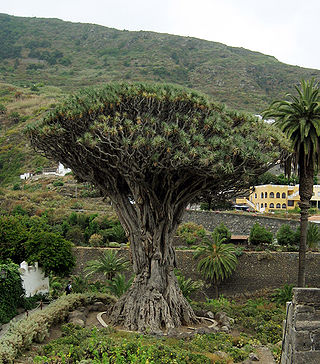
Dracaena is a genus of about 200 species of trees and succulent shrubs. The formerly accepted genera Pleomele and Sansevieria are now included in Dracaena. In the APG IV classification system, it is placed in the family Asparagaceae, subfamily Nolinoideae. It has also formerly been separated into the family Dracaenaceae or placed in the Agavaceae.

Dracaena trifasciata is a species of flowering plant in the family Asparagaceae, native to tropical West Africa from Nigeria east to the Congo. It is most commonly known as the snake plant, Saint George's sword, mother-in-law's tongue, and viper's bowstring hemp, among other names. Until 2017, it was known under the synonym Sansevieria trifasciata. This plant is often kept as a houseplant due to its non-demanding maintenance; they can survive with very little water and sun.
Snakeplant or snake plant may refer to:

The NASA Clean Air Study was a project led by the National Aeronautics and Space Administration (NASA) in association with the Associated Landscape Contractors of America (ALCA) in 1989, to research ways to clean the air in sealed environments such as space stations. Its results suggested that, in addition to absorbing carbon dioxide and releasing oxygen through photosynthesis, certain common indoor plants may also provide a natural way of removing volatile organic pollutants.
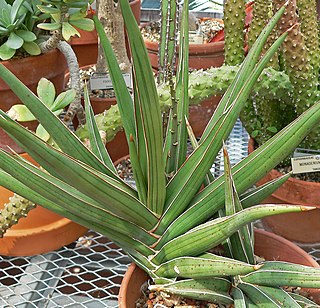
Dracaena hanningtonii, synonym Sansevieria ehrenbergii, is a flowering plant which grows in northeastern and eastern tropical Africa and the Arabian Peninsula. It occurs notably in proliferation along the Olduvai Gorge in northern Tanzania.

Sansevieria is a historically recognized genus of flowering plants, native to Africa, notably Madagascar, and southern Asia, now included in the genus Dracaena on the basis of molecular phylogenetic studies. Common names for the 70 or so species formerly placed in the genus include mother-in-law's tongue, devil's tongue, jinn's tongue, bow string hemp, snake plant and snake tongue. In the APG III classification system, Dracaena is placed in the family Asparagaceae, subfamily Nolinoideae. It has also been placed in the former family Dracaenaceae.

Dracaena fragrans, is a flowering plant species that is native throughout tropical Africa, from Sudan south to Mozambique, west to Côte d'Ivoire and southwest to Angola, growing in upland regions at 600–2,250 m (1,970–7,380 ft) altitude. It is also known as striped dracaena, compact dracaena, and corn plant.

Dracaena angolensis, commonly known as African spear or the spear sansevieria, is a succulent plant native to Angola in Southern Africa. For years, it was placed within the genus Sansevieria (snake-plants), a specific name which is still used synonymously by some; in the 21st century, Sansevieria became part of Dracaena (dragon-trees), after improved testing methods, physical comparisons, and other analyses found sufficient commonalities between the two genera to warrant subsumption.

Dracaena pethera, synonym Sansevieria kirkii, also known as star sansevieria, is a succulent plant native to Tanzania and the surrounding region in East Africa.
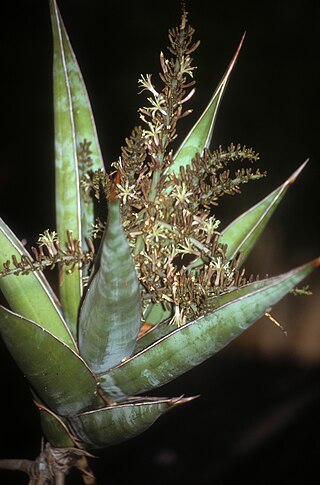
Dracaena pinguicula, synonym Sansevieria pinguicula, also known as the walking sansevieria, is a xerophytic CAM succulent native to the Bura area of Kenya, near Garissa. The species was described by Peter René Oscar Bally in 1943.
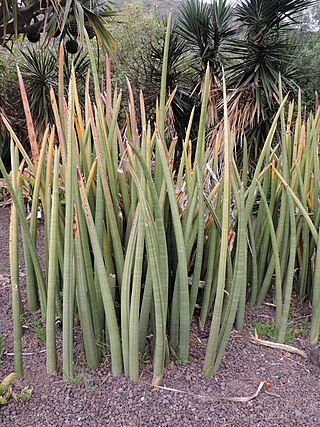
Dracaena stuckyi, synonym Sansevieria stuckyi, is a species of succulent plant native to Africa including Mozambique, Tanzania, and southern Kenya. It is a member of a group of related Dracaena including Dracaena angolensis and Dracaena pearsonii, that grow upright, cylindrical foliage and are native to dry biomes.

Dracaena eilensis, synonym Sansevieria eilensis, is a species of succulent plant native to a small region of Somalia near the town of Eyl. The species was collected in 1973 by John Lavranos.

Dracaena masoniana, synonym Sansevieria masoniana, is a species of Dracaena native to Africa and originally collected in the Democratic Republic of the Congo. It was initially known in cultivation under the cultivar name 'Mason Congo'. Commonly grown as a houseplant for its striking foliage, it can survive in bright filtered light or shade and with infrequent watering. Often grown as a single large, stiff leaf in pots, the plant's other common names include "whale fin" or "shark's fin".

Dracaena suffruticosa, synonym Sansevieria suffruticosa is a species of Dracaena native to eastern Africa, from Ethiopia to Malawi. The first description of the species was made in 1915 by N. E. Brown.

Dracaena arborescens, synonym Sansevieria arborescens, is a succulent plant native to Kenya and Tanzania.

Dracaena bagamoyensis, synonym Sansevieria bagamoyensis, also known as snake plant is a succulent plant native to Kenya and Tanzania.
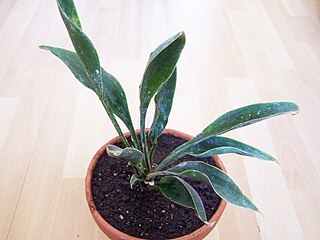
Dracaena spathulata is a species of flowering plant in the family Asparagaceae, native to South Africa (KwaZulu-Natal), Mozambique, Zimbabwe, and Tanzania. It was previously known under the synonym Sansevieria concinna.

Dracaena hallii is a species of succulent plant native to Mozambique, Zimbabwe, and Limpopo Province of South Africa. The species was named for Harry Hall, formerly the curator of succulents at Kirstenbosch National Botanical Garden in Cape Town. Commonly known as the "baseball bat" plant, it has extremely thick foliage with a rounded shape and a central channel.

Dracaena ballyi is a species of succulent plant native to Kenya and Tanzania. It grows in small rosettes with leaves that have bands of color and sharp tips. Originally collected by Peter Bally in 1963 and long cultivated as a houseplant, it was scientifically described in 2004.
Dracaena malawiana, synonym Sansevieria formosa, is a species of Dracaena native to Malawi. It was originally collected at the Kapichira Falls in south Malawi.

















